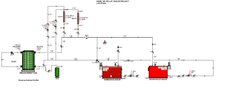I have been trying to dial in my pumps. I have three, leaving the oil boiler out of it. They are all infinitely adjustable B&G Ecocirc Varios.
The boiler nameplate is 15kw at 176, so 51,182 btu/hr.
House is 10 year old 2000 ft2 colonial, 1000 ft2 on each floor in upstate NY.
First floor baseboard emitter: 24,000 btu/hr @ 176F
Second floor baseboard emitter: 27,500 btu/hr @ 176F
I've been using Taco's HSS program and these are the numbers it came up with:
Second Floor:
2.5 gpm
11.5' head loss
First Floor:
2.8 gpm
6.8' head loss
Boiler:
5.3 gpm
5.7' head loss
Calculated baseboard at 176F heat load is 51,500, so boiler is just a tiny bit small when running at its max temp of 176.
I can see 5.3 for the boiler, but the other numbers seem high.
I am also now trying some thermometers on the return to shoot for a 20 degree drop.
This is for the max. How will things work at lower output?
Thanks.

The boiler nameplate is 15kw at 176, so 51,182 btu/hr.
House is 10 year old 2000 ft2 colonial, 1000 ft2 on each floor in upstate NY.
First floor baseboard emitter: 24,000 btu/hr @ 176F
Second floor baseboard emitter: 27,500 btu/hr @ 176F
I've been using Taco's HSS program and these are the numbers it came up with:
Second Floor:
2.5 gpm
11.5' head loss
First Floor:
2.8 gpm
6.8' head loss
Boiler:
5.3 gpm
5.7' head loss
Calculated baseboard at 176F heat load is 51,500, so boiler is just a tiny bit small when running at its max temp of 176.
I can see 5.3 for the boiler, but the other numbers seem high.
I am also now trying some thermometers on the return to shoot for a 20 degree drop.
This is for the max. How will things work at lower output?
Thanks.

Last edited:


